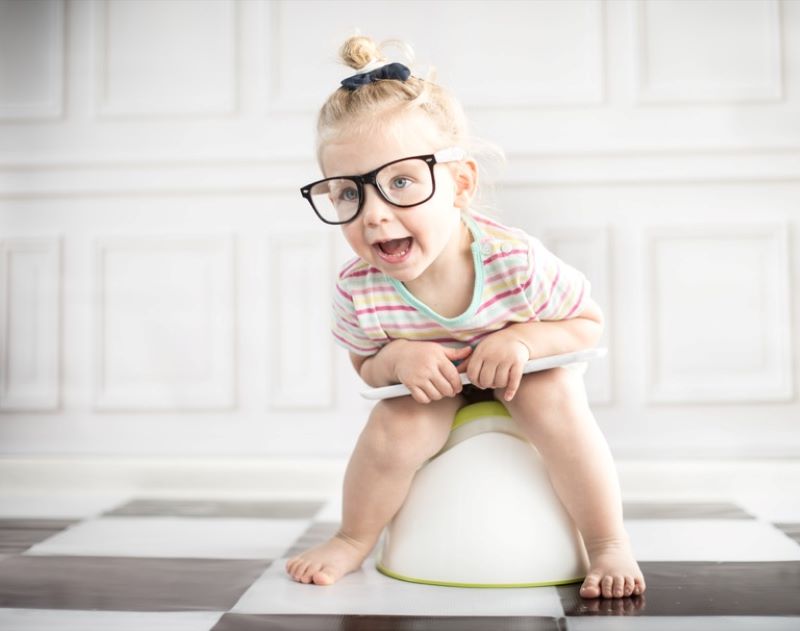When your sweet baby hits the toddler stage, you have finally gotten through the worst of their sleep speed bumps, and now you have to start thinking about potty training. You may be worried this introduction will disrupt their sleep. Your concern is legitimate, as you have likely put in a lot of work to train your toddler to sleep on their own.
Like any developmental milestone, toilet training can cause minor sleep regressions as they learn this new skill. However, it doesn’t have to be permanent. Your toddler will quickly return to sleeping through the night if they have a strong sleep foundation. Follow these tips to achieve good sleep through the potty training process:
Check For Readiness
Before attempting toilet training, your toddler should be ready. They should be able to communicate their need for the bathroom (either verbally or with signs) and understand and follow basic directions. They must independently sit down and walk. With or without minor assistance, they need to pull their pants on or off.
Potty-specific readiness signs include asking for a clean diaper when they’ve used it, hiding or finding a more private spot for number twos, and expressing interest in your toileting habits.
It is important to remember that children will not potty train themselves. Parents need to teach them, which is why it is called potty training. They will take to it with as much determination and attention as you put into it.
While there is no ideal age for potty training, the average window is 18 months to four years. It is much easier to train your toddler before they fully gain their sense of self and independence, exhibited when they embrace their favorite word – no. Once they start this, potty training becomes more of a battle of wills than if you can achieve it before this point.
It Should Be The Right Time For Everyone
While you want your toddler to be ready before they start declining everything, you must train when it’s a good time for you and your whole family. Ditching diapers during another significant change will not end well.
For example, if that readiness window hits around the time of a new little one’s arrival or moving houses, it’s not a good time to take on toilet training too. It will go smoother if you wait, and it won’t hurt them in the long run if they are past their “window.”
Make Sure They Are Healthy
Your child shouldn’t have any medical issues you are working through or illnesses, even minor ones like colds when you commence training. When in doubt, check with your pediatrician.
Additionally, you should start potty training when you have a good sleeper that isn’t already going through a developmental leap or regression. If they aren’t sleeping well, tackle that before throwing in toilet training. They will be more receptive to learning new skills when getting the rest they need.
Start with Daytime Training
The sensation of needing to use the toilet is much easier to teach during the day when your little one is awake. Once they recognize this and master the skill, they may start involuntarily holding it overnight or during naps.
While this is the dream, it doesn’t always happen. They may begin to resist pull-ups for bed, and you can decide if you are ready to start nighttime training. If not, reassure them that sleep will be long and that the pull-up is just in case. You will take it off as soon as they wake up, which typically does the trick.
Limit Evening Drinks and Snacks
Typically, children start to regulate their bowel movements when they start to master toileting, so nap or bedtime number twos usually clear up on their own. If they don’t, you will want to limit snacks beginning one to two hours before bed.
To ease into nighttime training, limit fluids two hours before bed so they will have an empty bladder for bedtime. Especially in a warmer climate, a nighttime drink is a must, so keep it under four ounces to help avoid night bathroom trips or accidents.
Have Easily Accessible Supplies for Accidents
Accidents are a sign of learning, and they are inevitable. When you do ditch the overnight diaper, have supplies on hand. A hospital-grade Chux pad, puppy pad, or a thick synthetic blanket nearby works well to cover the spot until morning. Or you can double layer a mattress protector and sheet over another set so you can quickly take the two off without having to remake the bed in the dark. Always have a spare set of easy-on pajamas to slip on your child.
Avoid The Bedtime Stall Tactics
Some toddlers get wise and use potty training to stall bedtime. Avoid this by incorporating toilet trips into your nighttime routine. For example, if you give a nightly bath, start having your child try to go on the potty while you are running the bath. If they go, great. If not, try again after bathtime. Then, when they are in bed, you can be confident they shouldn’t need to go, especially if you limit their fluid intake at night.
Having a small toddler potty in your child’s room will make it more convenient for them to go to the bathroom at night if needed, and you can use it for their final potty trip if they are trying to stall during the bedtime routine. Either they don’t need to go and won’t be interested when you offer the bedside potty, or they do need it and will quickly use it instead of making another trip to the bathroom, throwing off their nighttime wind down.
In the end, you know your child and will find the best method and tricks that work well for them. Be consistent, and the results will follow. There are always outliers, but most children do not start kindergarten without being toilet trained. Some may have been out of diapers for years, while others just kicked the habit. They will learn the skill with consistent positive reinforcement.
If you are concerned, speak to your doctor to rule out any potential roadblocks. Give yourself and your toddler some grace because if this were easy, you wouldn’t need to teach them. Give yourself a pat on the back—and your toddler, too, while you’re at it.


